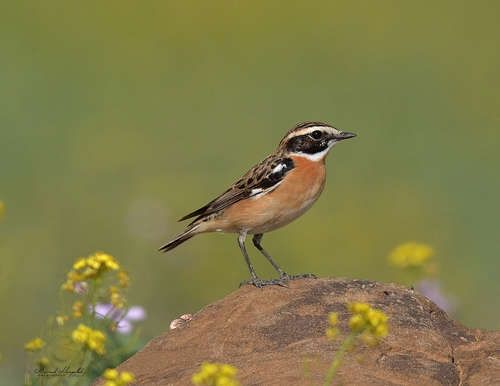
Whinchat
The Whinchat (*Saxicola rubetra*) is a small, migratory passerine bird known for its distinctive perching habit on prominent, low vegetation like gorse bushes (also known as "whin" bushes, hence the name). This Old World flycatcher plays a vital role in controlling insect populations within its grassland and agricultural habitats. It holds a certain charm for birdwatchers due to its subtle beauty and lively behavior. While not possessing any major cultural significance like some other species, its presence is often associated with healthy, open landscapes.
12-14 cm
Length
21-24 cm
Wingspan
Least Concern
Conservation Status
Distribution
Breeds across Europe and western Asia, extending east to central Siberia. Winters in sub-Saharan Africa. Migrates along broad fronts, with significant stopover sites in the Mediterranean region. The altitudinal range extends from sea level to mountain meadows, typically below 2000 meters.
Lifespan
Typically 2-3 years in the wild, although some individuals may live longer.
Whinchat's Habitat
Habitat Types
Open grasslands, Heathland, Agricultural fields with hedgerows, Meadows, Moorland fringes
Climate Zones
Temperate, Boreal
Adaptations
Prefers areas with scattered perches like bushes, fences, and tall herbaceous plants, which are essential for its hunting strategy. They have relatively long legs for perching and running on the ground.
Variations
No clearly defined subspecies are widely recognized, although minor variations in plumage and size may occur across its vast range.
Appearance
Breeding Plumage
Males in breeding plumage have a distinctive blackish face mask, a bold white supercilium (eyebrow stripe), and an orangey-buff breast. Females and non-breeding males are duller, with a less distinct face pattern and paler underparts.
Seasonal Feather Changes
After the breeding season, both sexes molt into a duller, non-breeding plumage. Juveniles resemble non-breeding females.
Sex Based Plumage Differences
Pronounced during the breeding season. Males are more brightly colored and patterned than females.
Notable Features
Prominent white supercilium, Dark cheek patch, White wing patches (visible in flight), Frequently flicks its wings and tail
Diet and Feeding
Primary Foods
Insects, Spiders, Small invertebrates, Berries (occasionally in autumn)
Foraging Behavior
Typically hunts from a perch, making short flights to capture insects in the air or on the ground. Also gleans insects from vegetation.
Specializations
No highly specialized feeding adaptations, but its perching habit and agility allow it to exploit a wide range of insect prey.
Seasonal Diet Variations
Primarily insectivorous during the breeding season. May consume more berries and other fruits during migration and in winter quarters.
Behavior
Social Structure
Generally solitary or in pairs during the breeding season. May form small, loose flocks during migration.
Communication
A short, sharp 'tack' call, A chattering alarm call, A thin, warbling song delivered from a perch or in flight
Migration
A long-distance migrant, traveling between Europe/Asia and sub-Saharan Africa. Migrates at night, often in loose flocks.
Territorial or Group Behaviors
Males are territorial during the breeding season, defending a small area around the nest site. Territories are often loosely clustered.
Conservation
Threats
Habitat loss and degradation (due to agricultural intensification), Pesticide use (reducing insect prey), Climate change (affecting breeding and wintering habitats)
Protection Programs
Agri-environment schemes (promoting wildlife-friendly farming practices), Habitat restoration projects
Local National Laws
Protected under various national and international wildlife legislation, such as the EU Birds Directive.
Population Trend
Decreasing in many parts of its range, particularly in Western Europe.
Population Estimates
The global population is estimated to be between 9,800,000 - 17,600,000 mature individuals.
Interesting Facts
Whinchats often return to the same breeding territories year after year.
This site fidelity demonstrates their strong connection to specific locations.
They are known for their habit of perching on prominent objects.
This provides a good vantage point for spotting prey and displaying to potential mates.
Their scientific name, *Saxicola rubetra*, reflects their habitat and color.
*Saxicola* means 'rock-dweller' (though they are not strictly rock-dwelling), and *rubetra* refers to the reddish-brown color of the male's breast.
Faqs about Whinchat
Where can I see a Whinchat?
Look for Whinchats in open grasslands, heathland, and farmland with scattered bushes and hedgerows during the breeding season (spring and summer) in Europe and western Asia. They are also found in sub-Saharan Africa during the winter.
What do Whinchats eat?
Whinchats primarily eat insects, spiders, and other small invertebrates. They may also eat berries, especially during migration.
Are Whinchats endangered?
Whinchats are currently classified as Least Concern by the IUCN, but their populations are declining in many areas due to habitat loss and agricultural intensification.
Copyright @ Nature Style Limited. All Rights Reserved.
 English
English